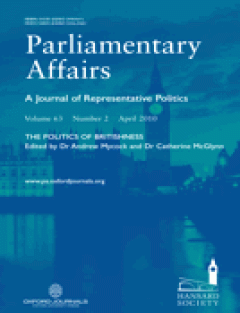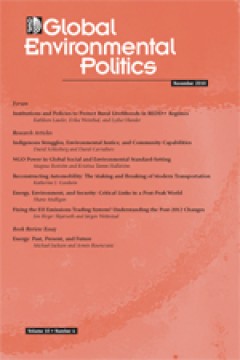Filter by

Strategic Recovery? The Conservatives Under David Cameron
Under David Cameron the Conservative party recovered sufficiently to deliver a Conservative Prime Minister. Cameron achieved what three leaders before him did not: a consistent poll lead over Labour and a broadening of the Conservative message. This chapter also highlights two major limitations to the Conservative ‘recovery’; (i) the size of the Conservative base has not enlarged: roughly the s…
- Edition
- Vol. 63. No. 4, October 2010.pp. 667-688
- ISBN/ISSN
- 00312290
- Collation
- -
- Series Title
- Parliamentary Affairs
- Call Number
- -

The Campaign That Changed Everything and Still Did Not Matter? The Liberal De…
This contribution examines the Liberal Democrat campaign and their subsequent performance in the 2010 General Election. Despite what appeared to be a ground-breaking campaign, the Liberal Democrat performance in the 2010 election was—as Clegg acknowledged—disappointing for the party. Here we argue that the story of the 2010 Liberal Democrat election was the remarkable similarity with 2005, with…
- Edition
- Vol. 63. No. 4. October 2010.pp. 689-707
- ISBN/ISSN
- 00312290
- Collation
- -
- Series Title
- Parliamentary Affairs
- Call Number
- -

A Catenaccio Game: the 2010 Election in Scotland
The result of the general election in Scotland was very different from the rest of the UK. No seats changed hands. Labour consolidated its position as the dominant party in Scotland. Cameron may have been able to detoxify the Conservatives’ image in England but failed to do the same in Scotland. The Liberal Democrats were the only major party in Scotland to see its vote share reduced. Neverthel…
- Edition
- Vol. 63. No. 4. October 2010.pp. 708-725
- ISBN/ISSN
- 00312290
- Collation
- -
- Series Title
- Parliamentary Affairs
- Call Number
- -

Wales and the 2010 General Election
Wales is distinctive in British general elections for its higher than average levels of support for the Labour Party. However, following evidence of Labour decline and public opposition after its unprecedented 13 years of office, there were questions over whether perceived Labour one-partyism in Wales would be finally superseded. In practice, although the election resulted in an increased fragm…
- Edition
- Vol. 63. No. 4. October 2010.pp. 726-741
- ISBN/ISSN
- 00312290
- Collation
- -
- Series Title
- Parliamentary Affairs
- Call Number
- -

Northern Ireland: Unionism Loses More Leaders
Northern Ireland's 2010 Westminster election saw the dramatic unseating of the First Minister, Peter Robinson, from his East Belfast seat by the cross-community Alliance Party. Beyond the headline scalp, the Democratic Unionist Party and Sinn Fein continued to dominate the Unionist and Nationalist electoral blocs, with Sinn Fein holding its five seats. This success raised the outside possibilit…
- Edition
- Vol.63. No 4. October 2010.pp. 742-759
- ISBN/ISSN
- 00312290
- Collation
- -
- Series Title
- Parliamentary Affairs
- Call Number
- -

‘Wags’, ‘Wives’ and ‘Mothers’ But what about Women Politicians?
The UK general election of 2010 should have been a critical one for women. But it was not to be. Despite all of the main political parties claiming to want more women MPs the increase in their number relative to the 2005 Parliament was just 2.5%. Women remain under-represented numerically in the House of Commons, constituting less than one-quarter of all MPs. The election campaign was largely w…
- Edition
- Vol. 63. No. 4. October 2010.pp. 760-777
- ISBN/ISSN
- 00312290
- Collation
- -
- Series Title
- Parliamentary Affairs
- Call Number
- -

Party Finance: Normal Service Resumed?
Whereas the period under Tony Blair had seen Labour emerge as the richer of the two largest parties, the 2010 election was characterised by significant disparities in party wealth, with the Conservatives emerging as the strongest party by some margin. This had a significant bearing on how the campaigns were fought, with Labour needing to make decisions on how to campaign based principally on wh…
- Edition
- Vol. 63. No. 4. October 2010.pp. 778-801
- ISBN/ISSN
- 00312290
- Collation
- -
- Series Title
- Parliamentary Affairs
- Call Number
- -

The Media and the 2010 Campaign: the Television Election?
The 2010 election was one of the most competitive campaigns of recent decades. The first televised leaders' debates along with the rise of online social networking led to renewed speculation about the potential influence of the media in campaigns. By contrast the press appeared to revert to pre mid-1990s form with strong support for the Conservatives and personal attacks on their opponents. Thi…
- Edition
- Vol. 63. No. 4. October 2010.pp. 802-817
- ISBN/ISSN
- 00312290
- Collation
- -
- Series Title
- Parliamentary Affairs
- Call Number
- -

From Big Government to Big Society: Changing the State–Society Balance
Much of the 2010 election was fought around the issue of the recession and the public borrowing deficit. However, whilst economic policy was highly salient, there was little fundamental difference between the parties over what needed to be done. All three of the major parties accepted the need to cut the deficit through reducing public expenditure. What the response to the crisis did reveal was…
- Edition
- Vol. 63. No. 4. October 2010.pp. 818-833
- ISBN/ISSN
- 00312290
- Collation
- -
- Series Title
- Parliamentary Affairs
- Call Number
- -

The Calm After the Storm? Foreign and Security Policy from Blair to Brown
This article examines the main aspects of the UK's foreign and security policy across the 2005–2010 Parliament. It begins by discussing the highpoint of foreign policy during the period, and goes on to consider the evolution of the UK's foreign policy doctrine, looking in particular at whether Brown established a world view that was distinctive from his predecessor. The analysis then turns to t…
- Edition
- Vol. 63. No 4. October 2010.pp. 834-848
- ISBN/ISSN
- 00312290
- Collation
- -
- Series Title
- Parliamentary Affairs
- Call Number
- -

Less Is More: Immigration and European Integration at the 2010 General Election
What impact did immigration and European integration have on the 2010 general election campaign and result? We explain why immigration was a salient campaign issue, while European integration barely figured. We show that the Conservatives learned to speak less about European integration and immigration as part of their re-evaluation of campaign strategy following three successive defeats. For d…
- Edition
- Vol. 63. No. 4. October 2010.pp. 849-865.
- ISBN/ISSN
- 00312290
- Collation
- -
- Series Title
- Parliamentary Affairs
- Call Number
- -

When Is Shuttle Diplomacy Worth the Commute? Information Sharing through Medi…
The authors study the conflict mediation problem, sometimes called “shuttle diplomacy,” when the mediator acts as a go-between and must gather information from the disputants. In the context of a general model of information mediation, they show that the incentive that disputants have to lie to the mediator undoes any advantage that might be gained by adding communication with a third party. In…
- Edition
- Vol. 62, No. 4 October 2010.pp. 530-560
- ISBN/ISSN
- 00438871
- Collation
- -
- Series Title
- WORLD POLITICS
- Call Number
- -

Looking Like a Winner: Candidate Appearance and Electoral Success in New Demo…
A flurry of recent studies indicates that candidates who simply look more capable or attractive are more likely to win elections. In this article, the authors investigate whether voters’ snap judgments of appearance travel across cultures and whether they influence elections in new democracies. They show unlabeled, black-and-white pictures of Mexican and Brazilian candidates’ faces to subjects …
- Edition
- Vol. 62, No. 4 October 2010.pp. 561-593
- ISBN/ISSN
- 00438871
- Collation
- -
- Series Title
- WORLD POLITICS
- Call Number
- -

Organizational Determinants of Wage Moderation
This article contributes to the political economic literature regarding the effects of industrial relations institutions on national economic outcomes. Based on an econometric analysis of the determinants of wage moderation in sixteen industrialized countries between 1974 and 2000, it argues that the organizational characteristics of trade unions have a significant impact on wage dynamics. Cont…
- Edition
- Vol. 62, No. 4 October 2010.pp. 594-636
- ISBN/ISSN
- 00438871
- Collation
- -
- Series Title
- WORLD POLITICS
- Call Number
- -

Varieties of Electioneering: Success Contagion and Presidential Campaigns in …
Existing theories of change in campaign strategies predict cross-national convergence in candidates’ linkages to voters and the degree of policy focus and cleavage priming in their appeals. However, the prevailing national patterns of electioneering in Chile, Brazil, and Peru have actually diverged from one another since their transitions from authoritarian rule. Based upon content analysis of …
- Edition
- Vol. 62, No. 4 October 2010.pp. 636-675
- ISBN/ISSN
- 00438871
- Collation
- -
- Series Title
- WORLD POLITICS
- Call Number
- -

Mobilizing Restraint: Economic Reform and the Politics of Industrial Protest …
The study draws on evidence from South Asia to explore how union partisan ties condition industrial protest in the context of rapid economic change. It argues that unions controlled by major political parties respond to the economic challenges of the postreform period by facilitating institutionalized grievance resolution and encouraging restraint in the collective bargaining arena. By contra…
- Edition
- Vol. 62, No. 4 October 2010.pp. 676-713
- ISBN/ISSN
- 00438871
- Collation
- -
- Series Title
- WORLD POLITICS
- Call Number
- -

Institutions and Policies to Protect Rural Livelihoods in REDD+ Regimes
While there is growing interest among researchers and practitioners concerning the risks that emerging REDD+ regimes pose to rural livelihoods, there has been little scholarly analysis of specific policies that could be applied to guard against these risks. We argue that for REDD+ regimes to avoid negative impacts on local populations, social safeguard policies will need to overcome the signifi…
- Edition
- Vol. 10, No. 4,November 2010. Pages 1-11
- ISBN/ISSN
- 15263800
- Collation
- -
- Series Title
- Global Environmental Politics
- Call Number
- -

Indigenous Struggles, Environmental Justice, and Community Capabilities
Environmental justice is often defined in terms of the distribution (or maldistribution) of environmental goods and bads. Activists and scholars have also focused on issues of cultural recognition and political participation. This article posits a capabilities-based conception of environmental justice. We argue that environmental challenges raised by indigenous communities demonstrate a broad, …
- Edition
- Vol. 10, No. 4, November 2010. Pages 12-35
- ISBN/ISSN
- 15263800
- Collation
- -
- Series Title
- Global Environmental Politics
- Call Number
- -

NGO Power in Global Social and Environmental Standard-Setting
We have seen a worldwide increase in new nonstate, multi-stakeholder organizations setting standards for socially and environmentally responsible behavior. These standard-setting arenas offer new channels for political participation for NGOs. Scholars have drawn attention to the rise and the role of NGOs in global politics, but there is less research on the power and long-term implications of N…
- Edition
- Vol. 10, No. 4, November 2010, Pages 36-59
- ISBN/ISSN
- 15263800
- Collation
- -
- Series Title
- Global Environmental Politics
- Call Number
- -

Reconstructing Automobility: The Making and Breaking of Modern Transportation
Automobility, the global system of human movement built around petroleumfueled cars, clearly has significant negative environmental consequences. Yet transforming this system presents a nearly overwhelming technological, cultural, and political challenge. The production of oil and cars is fundamental to modern capitalism and is a source of geopolitical power, while the consumption of these good…
- Edition
- Vol. 10, No. 4, November 2010, Pages 60-78
- ISBN/ISSN
- 15263800
- Collation
- -
- Series Title
- Global Environmental Politics
- Call Number
- -
 Computer Science, Information & General Works
Computer Science, Information & General Works  Philosophy & Psychology
Philosophy & Psychology  Religion
Religion  Social Sciences
Social Sciences  Language
Language  Pure Science
Pure Science  Applied Sciences
Applied Sciences  Art & Recreation
Art & Recreation  Literature
Literature  History & Geography
History & Geography